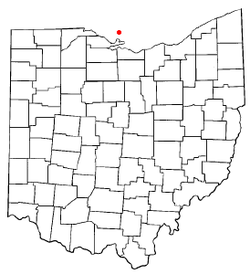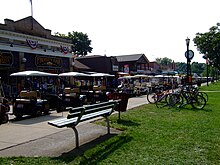Put-in-Bay, Ohio: Difference between revisions
this is not their official website |
|||
| Line 119: | Line 119: | ||
|blank1_name = |
|blank1_name = |
||
|blank1_info = |
|blank1_info = |
||
|website = |
|website = http://www.put-in-bay.com/ |
||
|footnotes = |
|footnotes = |
||
}} |
}} |
||
Revision as of 20:35, 7 June 2009
Put-in-Bay, Ohio | |
|---|---|
Village | |
 Aerial view looking down into the village's downtown area and DeRiveria Park (wooded area to the right). | |
 Location of Put-in-Bay, South Bass Island, Ohio | |
| Country | United States |
| State | Ohio |
| County | Ottawa County |
| Island in Lake Erie | South Bass |
| Area | |
| • Total | 0.6 sq mi (2 km2) |
| • Land | 0.5 sq mi (1 km2) |
| • Water | 0.2 sq mi (0.5 km2) |
| Elevation | 595 ft (181 m) |
| Population (2000) | |
| • Total | 128 |
| • Density | 279/sq mi (108/km2) |
| Time zone | UTC-5 (EST) |
| • Summer (DST) | UTC-4 (EDT) |
| Area code | 419 |
| Website | http://www.put-in-bay.com/ |
Put-in-Bay is a village located on South Bass Island in Put-in-Bay Township, Ottawa County, Ohio, United States. Many believe that the name originates from some early maps of South Bass Island that showed the harbor being named Pudding Bay, probably because it was shaped like a pudding sack.[1] The population was 128 at the 2000 census. The village played a significant role in the War of 1812 as the location of the squadron of U.S. naval commander Oliver Hazard Perry, who sailed from the port on September 10, 1813 to engage a British squadron just north of the island in the Battle of Lake Erie. The village is a popular summer resort and recreational destination. Ferry service connects it with Catawba Island, Kelleys Island, Port Clinton, and Sandusky, Ohio.
Geography
Put-in-Bay is located 15 miles (25 km) northwest of Sandusky, at 41°39′11″N 82°49′3″W / 41.65306°N 82.81750°WInvalid arguments have been passed to the {{#coordinates:}} function (41.653006, -82.817620).Template:GR
According to the United States Census Bureau, the village has a total area of 0.6 square miles (1.7 km²), of which, 0.5 square miles (1.2 km²) of it is land and 0.2 square miles (0.5 km²) of it (28.12%) is water.
Demographics
As of the censusTemplate:GR of 2000, there were 128 people, 67 households, and 36 families residing in the village. The population density was 279.2 persons per square mile (107.4/km²). There were 179 housing units at an average density of 390.5 per square mile (150.2/km²). The racial makeup of the village was 99.22% White and 0.78% from two or more races.
There were 67 households out of which 16.4% had children under the age of 18 living with them, 49.3% were married couples living together, 4.5% had a female householder with no husband present, and 44.8% were non-families. 41.8% of all households were made up of individuals and 6.0% had someone living alone who was 65 years of age or older. The average household size was 1.91 and the average family size was 2.59.
In the village the population was spread out with 15.6% under the age of 18, 4.7% from 18 to 24, 25.8% from 25 to 44, 38.3% from 45 to 64, and 15.6% who were 65 years of age or older. The median age was 47 years. For every 100 females there were 124.6 males. For every 100 females age 18 and over, there were 116.0 males.
The median income for a household in the village was $52,917, and the median income for a family was $80,000. Males had a median income of $47,083 versus $38,750 for females. The per capita income for the village was $35,301. None of the population and none of the families were below the poverty line.
Tourism

The island's primary industry is and for most of its history has been tourism. The tourist season runs roughly between April and October. The most common methods of transportation to and from the island are via ferry boat, propeller driven aircraft and private boat.
One of the world's largest hotels, the Hotel Victory, opened its 625 rooms to the public in 1892. The four-story hotel featured a one-thousand-seat dining room. However on August 14, 1919, the giant hotel burned to the ground. Today only parts of the foundations can be seen at the state campground.[1]
Put-in-Bay is the site of Perry's Victory and International Peace Memorial commemorating Commodore Oliver Hazard Perry's September 10, 1813 naval victory over British ships in the War of 1812. Construction of the monument began in 1912 and it opened to the public on June 13,1915. It is 352 feet (107 m) tall and made up of 78 layers of pink granite, topped with an eleven short ton (10 metric ton) bronze urn. Its height makes it the highest open-air observatory operated by the U.S. National Park Service. The remains of six naval officers, three British and three Americans, were interred beneath the floor of the monument's rotunda.



Other historical sites include:
- Stonehenge Estate – An estate with 19th century buildings that are listed on the National Register of Historic Places.
- Perry's Cave – Cave discovered by Native Americans. Perry sent men here during the War of 1812 (Battle of Lake Erie). Has an underground lake from which Perry's men obtained drinking water, after previously drinking from the bacteria filled Lake Erie water and getting sick. The water in the cave was clean and thus by drinking it, his men returned to health in order to win the battle.
- Heineman's winery and Crystal Cave – the world's largest geode.
- Lake Erie Islands Historical Society – 6,000 square foot (560 m²) museum that houses artifacts, memorabilia and genealogical data pertinent to the Lake Erie Islands.
- Beer Barrel Saloon – Houses the Guinness Book of World Records "World's 3rd Longest Bar" - 405 feet 10 inches (123.70 m) If it were stood on end, it would be taller than the (352 ft high) Perry's Monument.
There are approximately 200 full-time (South Bass Island) residents, most of whom remain on the island over the winter. Supplies and perishables are flown to the island during the winter months along with the mail, parcels and bank employees who staff the island's only bank (for one day a week) until the spring. The island has a single school that is used for all classes (grades kindergarten through 12) and also serves the educational requirements of Middle Bass and North Bass islands. These students arrive by plane, boat or ATV across the frozen lake depending on the season and weather.
Put-in-Bay has one grocery store, one hardware store, one school - which also houses the one lending library branch - one gas station, a post office, one bank and two cemeteries. It has two corporate franchise restaurants, Dairy Queen and Subway, and no cinema. The island does not have a hospital, but does have an Emergency Medical Service that can use a Life Flight helicopter to transport critically ill patients to mainland medical facilities. It is also home to the Put-in-Bay Airport.
In 1952-1959, and in 1963, the island held road races around a 3-mile (4.8 km) course. A modern R/C car track is in operation today.
The Boy Scouts of America hold an annual Camporee at the base of Perry's Monument.

References
- ^ a b Volgenau, Gerry (2005). Islands : Great Lakes stories. Ann Arbor, Michigan: Ann Arbor Media Group LLC. pp. 23–29. ISBN 1-58726-128-6.
{{cite book}}: Cite has empty unknown parameter:|coauthors=(help)

